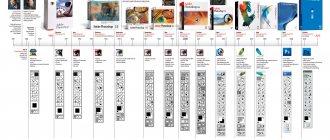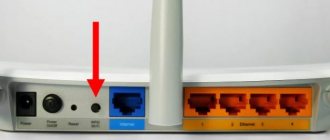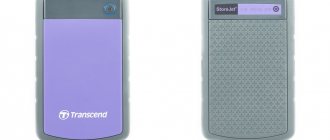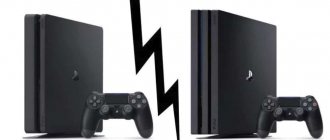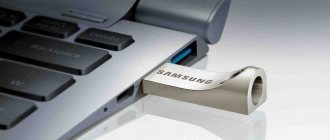Packaging and equipment
The Sound Blaster X3 is supplied in a cardboard box with a proprietary design. The packaging is decorated in light colors. The front part shows the device itself, and also lists its main capabilities and advantages.
At the back, the main technologies that have found their application in this card are described in several languages.
Inside, the card is fixed in cardboard form. For greater reliability, it is covered with shipping film.
The delivery set is small. In addition to the device itself, in the box we will find documentation and a cable for connecting the card to a PC.
Design and construction
Sound Blaster X3 is a kind of black square with a large volume control in the middle. The design is as strict and minimalist as possible. No aggressive broken lines and almost complete absence of decorative elements.
The body material was matte plastic. Fingerprints remain on it very reluctantly. The only glossy element is the insert in the recess near the volume control.
The regulator itself is completely smooth. The material is pleasant to the touch and has good grip. Rotation is very easy. The ride is as soft and smooth as possible. There is a thin chrome frame on top that breaks up the design a little and makes it a little more fun.
There are three keys on the front. They are used to activate the microphone, select equalizer presets, switch between headphones and line input, etc. We will consider their purpose in detail a little later.
At the front end there are two 3.5 mm jacks. They serve to connect headphones and a microphone.
The remaining ports are located on the back. Here we see line outputs, line input, optical output and a connector for connecting to a PC.
There are four rubber feet on the bottom. They do their job perfectly. The device stands like a glove and does not move on the table at all.
Microphone
The H5 TE and H7 TE have exactly the same detachable directional microphones with noise reduction and filtering out ambient sounds.
My teammates in Battlefield 1 and CS:GO heard me clearly and did not complain about the quality.
Connection and setup
We will look at the software a little later, since the device can work without installing it. The connection process is as simple and straightforward as possible. There are no difficulties with it. Everything is clear with the front connectors. They are used to connect a headset.
Rear line outputs are used to connect acoustics. If you plan to connect a 2.0 or 2.1 system, then only the “Front” output will be used. When connecting a 5.1 or 7.1 system, you will need all four connectors.
Next is the line input. After that there is an optical output.
To work, you need to connect the speakers to the desired output and connect the Sound Blaster X3 to a PC or other sound source. After automatic installation of the drivers, the card will be completely ready for use. Without installing additional software, configuration is carried out using three keys on the front side.
The first one is used to turn the microphone on/off. If you hold down the key, the Audio Balance function is activated. In this mode, the volume control is used to switch sound sources.
The second key switches preset equalizer settings and also activates Direct Mode.
And the SXFI key is used to activate this mode and switch between line input and headphones. It is worth remembering that SXFI technology only works with headphones.
When changing operating modes, the backlight color of the volume control also changes, and when switching between preset equalizer settings, the color of the indication above the corresponding key changes.
Blue illumination of the regulator - changing the volume level.
Red light – microphone volume.
Green – Audio Balance.
Testing
Test bench configuration
- Motherboard: MSI Z270 GAMING M7, BIOS v1.70;
- Processor: Intel Core i7 7700K;
- RAM: Kingston HyperX FURY Black [HX426C16FB3K4/32] 4×8 GB;
- Drive: WD Black NVMe SSD M.2 WDS256G2X0C NVMe PCI-E 3.0 ×4 256 GB;
- Power supply: Corsair RM750;
- Operating system: Windows 10 Pro 64-bit version 2004;
- Audio card driver: v6.0.105.52. Sound Blaster Commander v3.4.72.1.
RMAA tests
The sound characteristics of the audio card were measured in the Right Mark Audio Analyzer 6.4.5 program. Default settings, only the “one recording channel” or “two” mode was changed. The tests were run several times at different volume and recording settings.
The best results were obtained in 24-bit, 48 kHz mode. The Sound BlasterX AE-5 Plus gets an "excellent" rating.
Resulting graphs
The frequency response is uniform, at high frequencies the decline is only after 30 kHz, at the level of 20 kHz there are slight distortions in the graph, but they did not appear in other tests. At low frequencies the roll-off is no more than 0.5 dB below 50 Hz. By ear, rollovers of less than 0.5 dB even at 20 kHz will be simply unnoticeable.
The noise level and harmonic distortion are at a good level, it is slightly higher than the passport specifications, but this is normal for measurements in such conditions. Significant harmonic distortion noise, multiples of 1 kHz, is most likely the influence of electrical noise and interference from the PC itself.
There is no need to pay attention to high-frequency noise in the form of a hump from 20 to 40 kHz - this is its own noise beyond the audible limit. The penetration of mains 50 Hz and multiple harmonics is insignificant.
We also compared the card's performance in different modes: 16 bit 48 kHz, 24 bit 96 kHz and 32 bit 192 kHz.
The frequency response in 16-bit mode is the smoothest. There is also less harmonic distortion.
In terms of noise, the 24-bit mode looks most preferable, the difference is up to 30 dB with the 16-bit mode, this will already be noticeable by ear. The most harmonic distortion is observed in 32-bit mode.
We also built frequency response graphs when various SBX profiles were turned on. You can clearly see how the software improves the sound for games, movies and music (graphics in this order) - the low, upper mid and high frequencies are increased.
The listening sound was compared with the Asus Xonar DX discrete sound card and the Creative SXFI Amp external headphone amplifier. Before listening, we did a comparative test of these cards.
We will also provide a comparative graph of frequency response and THD among these sound cards.
As you can see, the AE-5 Plus demonstrates better performance in almost all respects.
BY
For more precise settings, you must install Sound Blaster Command software. You can download it from the manufacturer's official website. The interface is perfectly Russified and intuitive.
The first tab is SBX profiles. Here you can select a profile suitable for a specific task: various games, music, movies, etc. It is possible to edit preset and create new profiles. There are five settings available for configuration.
The second tab is SXFI. This function is only active with headphones connected.
To activate, you must first install the application on your phone, measure your head and ear, and then log into your profile from your PC. An impressive number of headphones from various manufacturers are available in the tear-off tab. If your headset model is not on the list, don’t be upset. You can choose a universal profile for over-ear headphones or earbuds.
Next is the equalizer. There are a variety of presets to suit different usage scenarios and music genres. You can reassign a specific equalizer to quickly activate using keys on the sound card itself.
The “Playback” tab, as you might guess, is used for settings for a specific system.
Here you can select the type of speaker connected to the card, etc. There is also a Direct Mode. This mode turns off all effects, and the user hears the sound in its pure form, without any “improvers”.
Next are the microphone settings. There are several effects to change your voice.
Scout Mode is perfect for various shooters, where it is important to hear every step and shot and clearly understand where it comes from. You can assign this mode to any key.
The encoder allows you to re-encode stereo into high-quality surround sound. This is only available when connecting speakers via an optical output.
At the very end there is a tab for the mixer and sound card and software settings.
Circuit design
The sound card is based on the ESS ES9016K2M SABRE32 Ultra DAC; this converter is found in High End equipment of the highest price category. This DAC supports a maximum bit depth of 32 bits and a sampling frequency of up to 384 KHz, a dynamic range of 122 dB, and a total harmonic distortion plus noise of 0.00032%.
The BlasterX Acoustic Engine sound processor consists of two chips: CA0113-4AG HF and CA0132-4AN HF; They are the ones who service the output channels and process sound, including virtual surround sound.
For the headphones, a Xamp amplifier is installed, assembled from four L4562 microcircuits, using a dual mono circuit with four discrete BD139 transistors and four capacitors.
Usage
First of all, I would like to note the ease of setup and connection of the Sound Blaster X3. The whole process is as simple and intuitive as possible. Next, I would like to praise the simple and convenient proprietary software, which makes working with the card even more convenient.
Let's start evaluating the work with SXFI technology. This is a proprietary virtual surround sound technology for headphones, which was released quite recently, but has already acquired a huge army of fans and collected an impressive number of awards. The company's product range already includes several models that support this technology. We will test using one of them as an example. We previously reviewed the Creative SXFI Air headset. As you can easily guess from the name, the device has support for SXFI technology, but it only works when connected wirelessly or when connected via a USB cable. By connecting the headset to the Sound Blaster X3, we can enjoy SXFI even when connected via a 3.5 mm cable.
There is no difference when activating SXFI on headphones and enabling this technology on the Sound Blaster X3. In both cases, the headphones deliver stunning surround sound and the sound quality remains unchanged.
Regular headphones that do not support SXFI are also noticeably transformed. Virtual surround sound seems quite realistic. Testing was carried out paired with a Creative Sound Blaster H5 TE headset. Positioning in games becomes clearer and clearer. Various special effects sound much more realistic and brighter. Scout Mode is also worth noting here. This is a specific equalizer setting that allows you to hear steps and various rustles around you as clearly as possible. It's perfect for shooter fans.
Let's look at the sound quality itself. Compared to a discrete map, it is difficult to find words to describe the scale of change. Even when connected via line outputs rather than optical, the sound quality and realism of various scenes increases many times over. The sound in films and games seems alive and real, and special effects and shots sometimes make you wince. Explosions, the roar of car engines, impacts, shots and other powerful effects received excellent attack and density.
Various supporting sounds are also given new life. There is no need to listen to make them out. Despite the very bright and saturated foreground, distant sounds do not suffer at all and remain perfectly audible.
Music lovers won't be disappointed either. Even the oldest and most beloved compositions begin to play in a new way. Songs that you seem to know by heart take on a new sound. Sound Blaster X3 copes equally well with absolutely any style of music and usage scenarios. Thanks to the abundance of effects and equalizer presets, you can choose settings for any song and genre. It makes no sense to describe every musical direction. Sound Blaster X3 is capable of playing any song. Dance and popular music sounds noticeably more powerful, heavy music amazes with the density and even viscosity of distorted guitars and the attack of a live drum kit. And even classical and instrumental compositions do not suffer at all. By turning off the effects and choosing the appropriate EQ setting, you can enjoy any light instrumental piece.
